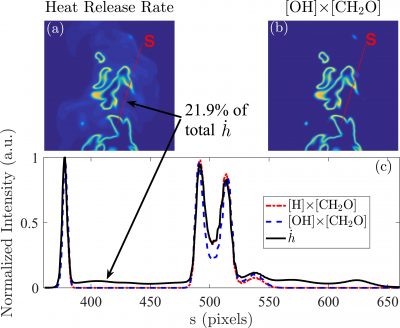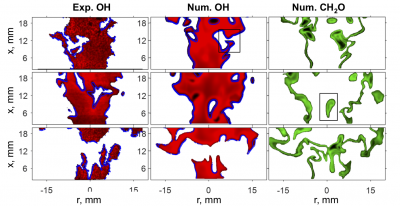Active collaboration with experimental partners to assess experimental procedures and to reduce uncertainties during model validation.

Comparison of the heat release rates obtained from DNS and obtained from the overlap between OH and CH2O. The overlapped signal approach fails to capture low-intensity heat release rates as much as 21.9%.
Several commonly used markers for heat release rates are compared, namely the CH, OH, and HCO radicals, as well as the spatial overlap of OH and CH2O and of H-atom and CH2O. The DNS data were also used to generate synthetic Planar Laser-Induced Fluorescence (PLIF) images that account for confounding experimental factors such as laser sheet thickness, optical blur, and shot noise. The overlap of OH and CH2O and the HCO radical appear to be the most promising markers of as they show excellent correlation with the high-intensity heat release. The synthetic-PLIF images show that increasing the laser sheet thickness and optical blur progressively de-correlates the measurement and the underlying DNS structures. However, for a sufficiently thin laser sheet (δsheet/δL ≲ 1), the correlation between the synthetic-PLIF and DNS remains strong even with significant optical blur. Similar results are observed in the measured layer thickness and the peak-to-peak distance between the PLIF structure and the heat release layers.
More interesting results are reported in T. M. Wabel, P. Zhang, X. Y. Zhao, H. Wang, E. Hawkes, A. M. Steinberg.
Assessment of chemical scalars for heat release rate measurement in highly turbulent premixed combustion including experimental factors. Combustion and Flame, Volume 194, 2018, Pages 485-506.

Instantaneous snapshots of the OH, CH2O obtained from PLIF measurements and from numerically-converted signals. The key flame features resemble one another very well.
Large eddy simulations of a bluff body stabilized propane flame, compared to experimental PLIF measurement by applying identical postprocessing of the numerical data. Such comparison is increasingly available due to today’s computational capacity, and can provide as a valuable tool to reduce the uncertainty in interpreting experimental results.
The results and more interesting observation are summarized in B. Wu, X. Y. Zhao, B. Chowdhury, B. Cetegen, C. Xu and T. Lu. A numerical investigation of the flame structure and blowoff characteristics of a bluff-body stabilized turbulent premixed flame. Submitted. 10/2018.